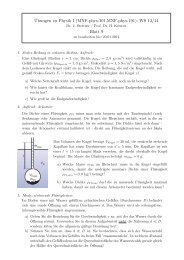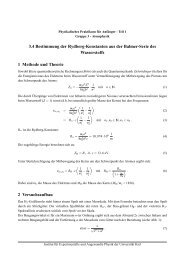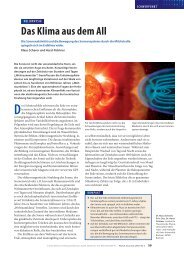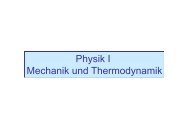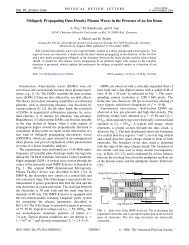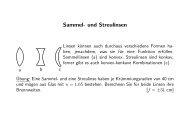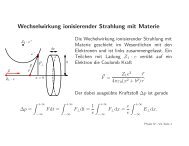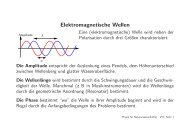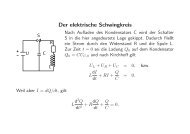Synthesis of the elements in stars: forty years of progress
Synthesis of the elements in stars: forty years of progress
Synthesis of the elements in stars: forty years of progress
You also want an ePaper? Increase the reach of your titles
YUMPU automatically turns print PDFs into web optimized ePapers that Google loves.
1008 Wallerste<strong>in</strong> et al.: <strong>Syn<strong>the</strong>sis</strong> <strong>of</strong> <strong>the</strong> <strong>elements</strong><br />
sult <strong>in</strong> a dramatic <strong>in</strong>crease <strong>in</strong> <strong>the</strong> mass-loss rate with<br />
<strong>in</strong>creas<strong>in</strong>g lum<strong>in</strong>osity. Sto<strong>the</strong>rs and Ch<strong>in</strong> (1993a, 1993b,<br />
1996) suggest ano<strong>the</strong>r mechanism <strong>of</strong> enhanced mass loss<br />
<strong>in</strong>volv<strong>in</strong>g a classical ionization <strong>in</strong>stability <strong>in</strong> <strong>the</strong> stellar<br />
envelope. In both cases, enhanced mass loss <strong>in</strong>hibits<br />
evolution <strong>in</strong>to <strong>the</strong> Humphreys-Davidson forbidden<br />
zone. Whatever <strong>the</strong> source <strong>of</strong> <strong>the</strong> <strong>in</strong>stability, <strong>the</strong> observations<br />
show that s<strong>in</strong>gle <strong>stars</strong> <strong>in</strong>itially more massive than<br />
50M do not become giants before experienc<strong>in</strong>g a supernova<br />
explosion, and this has important ramifications<br />
for massive close b<strong>in</strong>ary star evolution.<br />
It is clear that massive <strong>stars</strong> <strong>in</strong>teract with <strong>the</strong> <strong>in</strong>terstellar<br />
medium both as energy sources and sources <strong>of</strong> isotope<br />
enrichment prior to <strong>the</strong> supernova explosion that<br />
term<strong>in</strong>ates <strong>the</strong>ir lives. Some aspects <strong>of</strong> this <strong>in</strong>teraction<br />
are explored <strong>in</strong> a recent volume by Kunth et al. (1997).<br />
Models <strong>of</strong> Galactic chemical evolution (e.g., Pagel, 1989;<br />
Matteuchi, 1989; and Taylor, 1990) rely heavily on <strong>the</strong>oretical<br />
estimates <strong>of</strong> <strong>the</strong> nucleosyn<strong>the</strong>tic yields <strong>of</strong> massive<br />
<strong>stars</strong> (e.g., Maeder, 1992; Timmes et al., 1996;<br />
Thielemann et al., 1986; Arnett 1996), but uncerta<strong>in</strong>ties<br />
still rema<strong>in</strong> (Arnett, 1995), particularly with regard to<br />
<strong>the</strong> extent <strong>of</strong> mass loss prior to <strong>the</strong> supernova explosion<br />
and with regard to <strong>the</strong> divid<strong>in</strong>g l<strong>in</strong>e <strong>in</strong> <strong>in</strong>itial mass between<br />
those <strong>stars</strong> which form BHs and <strong>the</strong>refore do not<br />
return iron-peak <strong>elements</strong> to <strong>the</strong> <strong>in</strong>terstellar medium<br />
and those which form NSs and do (Maeder, 1992;<br />
Timmes et al., 1996).<br />
After <strong>the</strong> core carbon-burn<strong>in</strong>g phase, <strong>the</strong> chemically<br />
evolved <strong>in</strong>terior <strong>of</strong> massive <strong>stars</strong> follows one <strong>of</strong> two evolutionary<br />
paths, depend<strong>in</strong>g on <strong>the</strong> <strong>in</strong>itial stellar mass and<br />
composition. For solarlike <strong>in</strong>itial composition, models <strong>of</strong><br />
<strong>in</strong>itial mass <strong>in</strong> <strong>the</strong> 11 – 13 M range experience core collapse<br />
<strong>in</strong>itiated by electron capture before <strong>the</strong>y form an<br />
‘‘Fe-Ni’’ core (see below); <strong>in</strong> more massive models, core<br />
collapse is <strong>in</strong>itiated after <strong>the</strong> formation <strong>of</strong> <strong>the</strong> Fe-Ni<br />
core. A model star <strong>of</strong> mass 11M is just at <strong>the</strong> borderl<strong>in</strong>e<br />
between <strong>stars</strong> that become TPAGB <strong>stars</strong> with stable<br />
electron-degenerate cores <strong>of</strong> ONe and <strong>stars</strong> that immediately<br />
form electron-degenerate ONe cores massive<br />
enough that electron captures on 20 Ne, 23 Na, and 24 Mg<br />
trigger a rapid contraction that cannot be halted even by<br />
explosive O and Ne burn<strong>in</strong>g (Miyaji et al., 1980; Nomoto,<br />
1984, 1987; Miyaji and Nomoto, 1987; Gutierrez<br />
et al., 1996). Nuclear reactions convert <strong>the</strong> composition<br />
<strong>of</strong> <strong>the</strong> core <strong>in</strong>to iron-peak isotopes, and <strong>the</strong> Fe-Ni core<br />
collapses dynamically to nuclear matter densities. The<br />
real analog <strong>of</strong> <strong>the</strong> 11M model and real analogs <strong>of</strong> models<br />
slightly less massive (say 10.75M ) probably live<br />
long enough as AGB <strong>stars</strong> that <strong>the</strong> ONe core becomes<br />
massive enough and <strong>the</strong>refore dense enough to evolve<br />
<strong>in</strong>to a NS (Nomoto, 1987).<br />
Model <strong>stars</strong> more massive than 13M burn carbon,<br />
neon, oxygen, and silicon quiescently and <strong>the</strong>n form a<br />
core <strong>of</strong> iron-peak isotopes <strong>in</strong> statistical equilibrium (see<br />
Clayton, 1968; Arnett 1996; and Meyer, this review, Sec.<br />
XV). Beyond <strong>the</strong> core carbon-burn<strong>in</strong>g phase (e.g., <strong>the</strong><br />
third heavy portion along <strong>the</strong> 25M track <strong>in</strong> Fig. 1),<br />
<strong>the</strong>re is essentially no motion <strong>in</strong> <strong>the</strong> H-R diagram; <strong>the</strong><br />
rapidly evolv<strong>in</strong>g core and <strong>the</strong> hydrogen-rich envelope<br />
are essentially decoupled. Contraction and heat<strong>in</strong>g <strong>of</strong><br />
<strong>the</strong> Fe-Ni core leads to partial photodis<strong>in</strong>tegration <strong>of</strong><br />
iron-peak isotopes <strong>in</strong>to alpha particles and neutrons (B<br />
2 FH; Hoyle and Fowler, 1960; Fowler and Hoyle, 1964).<br />
Details <strong>of</strong> <strong>the</strong> subsequent dynamical collapse <strong>of</strong> <strong>the</strong><br />
core, neutronization, trapp<strong>in</strong>g <strong>of</strong> neutr<strong>in</strong>os, core bounce,<br />
and expulsion <strong>of</strong> <strong>the</strong> envelope <strong>in</strong> a type II supernova<br />
(SNII) explosion are described by many authors (e.g.,<br />
Woosley and Weaver 1986; Arnett, 1996). The supernova<br />
ejecta conta<strong>in</strong>s 56 Ni, which beta decays <strong>in</strong>to 56 Co,<br />
which <strong>in</strong> turn beta decays <strong>in</strong>to 56 Fe. Associated gamma<br />
emission from <strong>the</strong> decay <strong>of</strong> excited nuclear levels helps<br />
power <strong>the</strong> light curve. Analysis <strong>of</strong> <strong>the</strong> light curve <strong>of</strong><br />
SN1987a <strong>in</strong> <strong>the</strong> Large Magellanic Cloud (Arnett et al.,<br />
1989 and references <strong>the</strong>re<strong>in</strong>) suggests that 0.1M <strong>of</strong><br />
56 Fe is ejected <strong>in</strong>to <strong>the</strong> <strong>in</strong>terstellar medium when a star<br />
<strong>of</strong> <strong>in</strong>itial mass 20M explodes, show<strong>in</strong>g that SNeII are<br />
potent sources <strong>of</strong> iron <strong>in</strong> <strong>the</strong> Universe. That <strong>the</strong>y must<br />
also be major sources <strong>of</strong> o<strong>the</strong>r heavy <strong>elements</strong> follows<br />
from detailed models <strong>of</strong> explosions set <strong>of</strong>f <strong>in</strong> <strong>the</strong> envelopes<br />
<strong>of</strong> evolutionary models that have been carried to<br />
<strong>the</strong> stage <strong>of</strong> Fe-Ni core collapse (e.g., Thielemann et al.,<br />
1996, and references <strong>the</strong>re<strong>in</strong>).<br />
Despite much effort expended over <strong>the</strong> past 40 <strong>years</strong>,<br />
an unambiguous <strong>the</strong>oretical picture <strong>of</strong> <strong>the</strong> detachment<br />
<strong>of</strong> <strong>the</strong> neutronized, lepton-degenerate core has not yet<br />
emerged, although <strong>the</strong> evolution <strong>of</strong> <strong>the</strong> f<strong>in</strong>al detached<br />
core is reasonably well understood (Burrows and Lattimer,<br />
1986, 1987). The details <strong>of</strong> how energy is transferred<br />
from <strong>the</strong> core <strong>in</strong> such a way as to cause expulsion<br />
<strong>of</strong> <strong>the</strong> stellar envelope and a quantitative estimate <strong>of</strong><br />
how much matter falls back onto <strong>the</strong> core are not yet<br />
known <strong>the</strong>oretically. Thus, a secure <strong>the</strong>oretical mapp<strong>in</strong>g<br />
between <strong>in</strong>itial ma<strong>in</strong>-sequence mass and f<strong>in</strong>al NS or BH<br />
mass is not presently available (although, see Timmes<br />
et al., 1996 for an encourag<strong>in</strong>g effort), and <strong>the</strong> critical<br />
<strong>in</strong>itial mass M crit which separates <strong>stars</strong> that form NS<br />
remnants from those that form BH remnants is not<br />
known. However, an understand<strong>in</strong>g <strong>of</strong> massive close b<strong>in</strong>ary<br />
evolution requires this <strong>in</strong>formation. In order to<br />
make <strong>progress</strong>, a concrete choice must be made, and, <strong>in</strong><br />
<strong>the</strong> follow<strong>in</strong>g, it will be assumed that M crit 40M ,<br />
M NS 1.4M , and M BH 10M . The choice <strong>of</strong> 1.4M <br />
for <strong>the</strong> gravitational mass <strong>of</strong> a typical neutron star is not<br />
<strong>in</strong>consistent with <strong>the</strong> average value <strong>of</strong> 1.350.27 estimated<br />
by Thorsett et al. (1993) for 17 NSs <strong>in</strong> b<strong>in</strong>ary systems.<br />
Historically, supernovae have been classified primarily<br />
on <strong>the</strong> basis <strong>of</strong> <strong>the</strong>ir spectral features, with type I<br />
SNe (SNeI) be<strong>in</strong>g hydrogen deficient and SNeII exhibit<strong>in</strong>g<br />
hydrogen l<strong>in</strong>es. The SN light curve has <strong>in</strong> recent<br />
<strong>years</strong> become important <strong>in</strong> identify<strong>in</strong>g <strong>the</strong> nature <strong>of</strong> <strong>the</strong><br />
explosion. Comparison between spectral features and<br />
light curves <strong>of</strong> <strong>the</strong>oretical models <strong>of</strong> explosions (see,<br />
e.g., Wheeler et al., 1995) suggest that SNeII are <strong>the</strong> end<br />
result <strong>of</strong> <strong>the</strong> evolution <strong>of</strong> massive <strong>stars</strong> that reta<strong>in</strong> <strong>the</strong>ir<br />
hydrogen-rich envelopes and explode as red or blue supergiants<br />
(e.g., SN1987A), and that SNeIb,c are <strong>the</strong> result<br />
<strong>of</strong> <strong>the</strong> evolution <strong>of</strong> <strong>stars</strong> that become WR <strong>stars</strong> before<br />
explod<strong>in</strong>g. In close b<strong>in</strong>aries, <strong>the</strong> primary may<br />
Rev. Mod. Phys., Vol. 69, No. 4, October 1997



